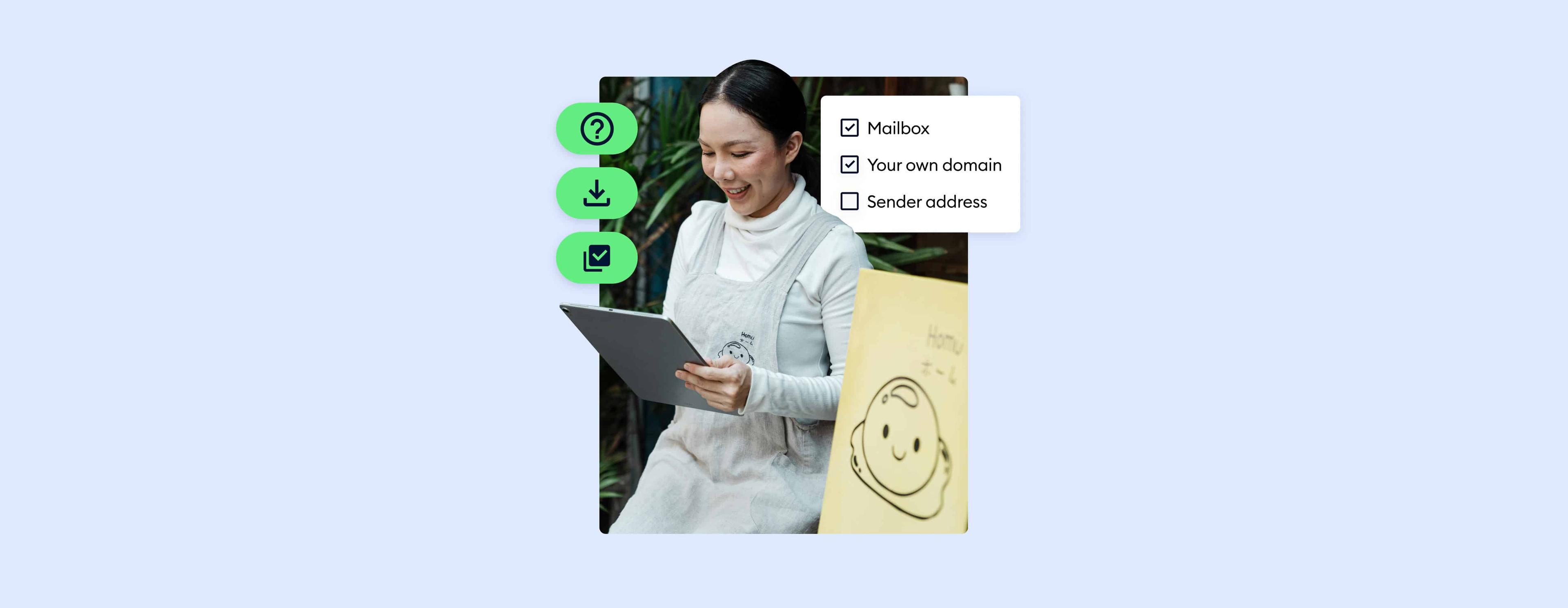A large part of delivering excellent customer experience comes down to a well-organized help desk.
This not only serves as the backbone for an impressive support department but also enhances client satisfaction, ultimately leading to higher customer loyalty.
But there are a lot of aspects to consider when creating the perfect workflow for your support processes. And that’s exactly where creating a help desk checklist can help.
So, where to start, and what to include in this cheat sheet?
Don’t worry—we’ve got you covered.
Use the help desk checklist template and set your support up for success
First things first—
Why is help desk important for customer experience?
The help desk provides a centralized system for resolving technical difficulties and ensuring all users get the help they need. As such, this department is a vital part of any successful customer support system.
Here are a few reasons why a properly set-up help desk is important in a business environment:

Centralized communication
By offering a single point of contact for all customer issues and queries, help desks streamline communication and make it easier for agents to provide support, reducing downtime and increasing staff productivity. This centralized communication is crucial as research indicates that 9 in 10 customers prefer consistent omnichannel experience.
Boosted efficiency and organization
Help desk software allows ticketing management and tracking. This ensures each problem is effectively handled and resolved, increasing efficiency and providing a top-notch user experience. In fact, a report shows businesses that offer superior client experiences get a 4 to 8% boost in revenue.
Data analysis
Help desks track customer interactions, which can provide valuable data on the client, common issues, and resolution times. This helps agents to provide omnichannel service for the user across different platforms and look through the customer’s history with the brand for better support. According to Gladly’s report, current clients expect CS teams to have a support-related history of their interactions with the business.
Who can benefit from using a help desk checklist?
Help desk checklists can benefit a wide range of people working in customer service and IT management.
These include, but aren’t limited to:
- Support agents—front-line staff can use it to ensure they tackle each customer request
- IT managers—the list helps managers monitor their team performance Customers/clients—the system’s structured approach results in higher support quality
- System administrators—it can help admins with routine system maintenance tasks
- IT support staff—the checklist ensures all standard procedures are followed
- Technicians/engineers—it helps in troubleshooting technical problems
- Training new staff—the list can also act as a training guide for new help desk hires
Finally, this type of list can be beneficial to anyone wanting to enhance their customer service and boost client loyalty, regardless if they’re just starting out or have been in the game for a while.
Increase the value of your help desk with a practical cheat sheet
With that out of the way, let’s move on to the guide itself.
Help desk checklist: 12 key points to consider
An effective help desk cheat sheet serves as a valuable tool in guiding support professionals through a streamlined process, ensuring nothing slips through the cracks.
Here are the 12 crucial points you should include when implementing a help desk checklist for top-notch customer service:
1. Set up communication channels
Establishing various communication channels is the first checkpoint when configuring your help desk. These channels are pathways that grant users easy access to your help desk services and encourage smooth interactions.
What communication channels to consider?
There are several popular channels frequently used by help desk teams, including:
- Phone support—phone calls offer real-time support and enable immediate troubleshooting, making them ideal for urgent issues
- Email—it’s a versatile, old-school form of communication that allows time for in-depth responses and can be used to share supporting documents
- Live chat—usually embedded on a website, a live chat widget can provide immediate personalized assistance
- Social media—platforms like Facebook Messenger, Instagram, and/or WhatsApp offer an opportunity to interact with customers using their preferred communication service
- Customer self-service portals—these can include FAQs, tutorials, AI chatbots, and automated troubleshooting steps that allow users to resolve issues independently
- Video calls/video conferencing—they are ideal for complex issues that require detailed, step-by-step resolutions or for simulating in-person customer service
How to connect different channels to your help desk software?
There’s the ability to integrate different communication channels with Tidio, aside from live chat and email. This includes the likes of WhatsApp automation, as well as Instagram and Messenger integrations.
To activate a channel, go to Integrations >> Communication channels. You can start the process by hovering over the channel you want to add and hitting the Install integration button.

Remember, the ultimate goal is to be present on the channels that your clients prefer and use most often.
Read more: Explore the best help desk ticketing system options available on the web.
2. Define clear roles and permissions
Each help desk team member should have a clear understanding of their roles, responsibilities, and the level of authority they hold. These roles could range from front-line technicians and help desk managers to system administrators.
Why is defining roles important?
Establishing these parameters reduces confusion, prevents overlaps, and maintains a focused, streamlined workflow. It also helps employees know who to escalate issues to when they face challenges beyond their scope of expertise. Additionally, well-defined roles contribute to better accountability as tasks and responsibilities are clearly set.
At the same time, permissions tied to specific roles ensure the right people have the right level of access to match their tasks. This not only safeguards sensitive information but also protects the system from accidental misuse.
How to define roles and permissions in a help desk system?
To change the operator’s permissions using Tidio, head to Settings >> Operators located in your admin panel. Then, hit the Edit permission button next to the operator’s details on the right-hand side to make any changes. You can also establish custom permissions for operators, choosing from Admin, Moderator, and Chat Agent.

Read more: Learn all about adding permissions in Tidio.
3. Organize your agents by departments
You can divide the agents in your team by departments based on their expertise and the issues they handle. This helps you ensure that support tickets are routed to the most appropriate team members. The task assignment allows you to optimize your time and establishes a more organized structure, encouraging enhanced customer service experience as a result.
Why does organizing agents by department matter so much?
Let’s say you’re a company with various products ranging from hardware like laptops to software like project management tools. When customers raise tickets concerning a hardware issue, directing the query to a number of agents specializing in hardware troubleshooting will likely ensure a quicker and more accurate resolution. On the other hand, software-related customer queries could go to agents with a good understanding of the tools’ functionality.
How to sort representatives by departments?
To organize agents by departments in Tidio, simply head to Settings >> General >> Team >> Departments. Click the Add new department button and set the department’s name as well as its operators. You can assign as many operators as you like. Also, one agent can be a member of multiple departments.

4. Set your operating business hours
This is a critical aspect of a well-functioning customer service. If you own a global company working across multiple time zones, your help desk may need to operate 24/7 to accommodate clients around the world. However, if your business primarily serves shoppers in a specific region, then you can align your operating hours accordingly. It’s also important to specify whether these hours include weekends or are limited to weekdays only.
Why is setting operating business hours important?
Clearly defined operating hours ensure clients understand when they can expect to receive support. Moreover, setting business hours helps your support team align their work schedules and availability.
Take a traditional brick-and-mortar store as an example. These types of stores maintain specific operating hours in accordance with local regulations and customer trends. Simply put, both types of businesses need to establish these hours to effectively manage employee schedules and customer expectations.
That being said, the flexibility and accessibility offered by online businesses provide a stark contrast to the usual business hours of physical stores.
How to define operating hours on your help desk platform?
To automatically adjust the online hours of operators in Tidio, you should go to Settings >> Personal >> Operating Hours. Make sure that the Operating hours toggle is enabled.
Operating hours are based on your current time zone, so be sure to configure the correct time zone at the end of the Operating Hours section.
To select the time when you’re online, simply move the white circle and toggle it between the preferred hours.

In case 24/7 live support isn’t possible, you can set up self-help resources such as FAQ chatbots, or automated email responses outside of working hours. This ensures that customers have access to some degree of assistance at all times. For example, Tidio has chat flow templates like “Keep in touch on weekends” which you can activate to inform users you’re available.
Read more: Explore various practical chatbot templates and examples.
5. Create help desk workflows
Help desk workflows allow you to determine the sequence of tasks from the moment a ticket is raised based on its type and urgency. This systematic approach ensures coordinated responses and successful help desk management, reducing room for errors or overlooked support tickets.
Some of the common tasks and features related to help desk workflows include assigning tickets to the appropriate agent or department(s), ticket prioritization and status, internal notes, and feedback surveys.
How does that work in real-life scenarios?
Take a typical scenario where a user submits a ticket about a technical issue they’re experiencing. The workflow will start with an automatic acknowledgment of the ticket, followed by an assignment to an agent based on the issue type. The representative then reviews, troubleshoots, and responds to the user with a solution or requests additional information. After the problem is resolved, the ticket is closed, and a follow-up is carried out to ensure complete customer satisfaction.
How to view the ticket information on your help desk system?
Once you open the ticket, on the right side of the screen, you will see the Info tab. Here, you will find the sender’s data, and details such as ticket status, assignee, and priority.

6. Automate whenever you can
Consider the process of ticket assignment. Rather than manually sorting and assigning each ticket to a suitable agent, an automated ticketing system can do this based on predefined rules, reducing the response time significantly.
Why is this important?
By automating repetitive tasks, your help desk team will have more time to focus on complex issues requiring a human touch, all while maintaining a consistent, 24/7 support presence. Automation not only increases productivity but also reduces the chance of human errors and enhances the overall user experience.
How to automate your help desk system?
In Tidio, you can automatically assign tickets by going to Settings >> Chat assignment. Here, you can select the Round Robin option which allows the automatic assignment of operators.
In addition, you can set the Automatic response feature to answer incoming tickets on auto-pilot. To do this in Tidio, head to Settings and then choose Helpdesk >> Automatic Response.

Aside from these options, you can also create a chat survey to allow users to determine which department they want to receive help from.
7. Create a clear distribution of tickets
Tickets could be distributed based on various criteria like the specific technical expertise required, the severity of the problem, or even the geographic location of the client.
Say that you’re a software company with a global reach that has localized help teams in multiple regions. When a ticket is raised, an automatic system identifies the location of the user and reroutes the ticket to the team responsible for that specific region. This ensures the customer receives support optimized for their specific regional context.
Why is a clear distribution of tickets important?
A well-defined distribution system for the help desk promotes efficient management and more timely resolution of problems. Also, a clear distribution model maintains a balanced workload among team members, preventing the overload of some while others are underused.
How to set up a ticket distribution?
In Tidio, you can make use of the custom ticket views feature to set different rules and conditions for various tickets and distribute them accordingly. You can do this by heading to Inbox in Tidio’s panel and hitting the Create view button.
For example, you can add a custom view related to the ticket in question, like “order status”. Then, you can select whether this ticket will be visible to you, all operators, or a specific person.

You can further customize the conditions under which the ticket will be distributed using the Conditions options located right below. Feel free to pick as many conditions as you like.
8. Filter tickets by priority
Filtering tickets by priority is a core task in help desk operations. Let’s consider a situation where two tickets are raised simultaneously: one detailing a minor software glitch affecting a single user, and a second reporting a critical server outage impacting multiple clients. The latter, being a high-priority issue, should be handled immediately as it can directly jeopardize the business and its customers.
Why does prioritizing tickets matter?
Not all issues have the same impact on business functions, and accurately assigning priority levels allows your team to handle issues that might cause the most disruption first. Prioritizing tickets also helps manage workflow, ensures prompt responses to urgent service requests, and maximizes resource utilization.
How to set priority in your help desk platform?
To define ticket priority in Tidio, you can open the ticket in question and click the Priority dropdown located on the right-hand side of the screen. The options available are Low, Normal, and Urgent.
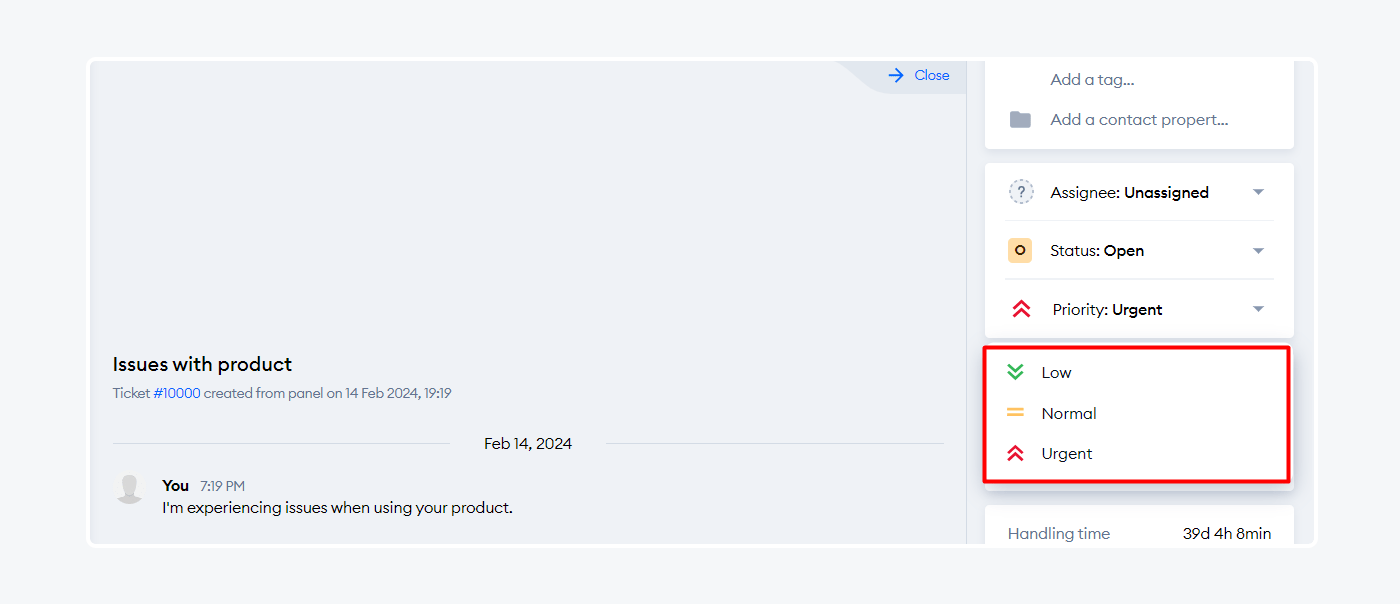
9. Use the help of AI and chatbots
Let’s take the recurring help desk support questions regarding password resets as an example. A chatbot powered by AI could handle such queries effectively without human intervention. It can guide users through password reset procedures, give them notifications about the latest software updates, or provide step-by-step solutions to common issues.
Why including this step in your checklist important?
Leveraging the power of Artificial Intelligence (AI) and chat flows is increasingly beneficial in modern help desk operations. Conversational AI can handle a significant volume of inquiries independently, providing immediate responses and dealing with common issues. This leaves your human agents free to focus on more complex requests. In addition to efficiency, helpdesk AI and flows offer 24/7 real-time assistance, promoting a better customer experience.
How to set up chatbots using a third-party provider?
Tidio’s Lyro is one such AI chatbot capable of answering common queries in a natural, human-like manner. All you have to do to leverage its power is select the Lyro AI chatbot located in Tidio’s main panel. Then, click on Start using Lyro and decide whether you want to add the question-answer pairs from your website’s URL or write them manually. Once you’re done, Lyro will take care of the rest.

Read more: Find out how Tidio’s support team achieved 58% automation using Lyro.
10. Analyze the performance of your help desk
You should track help desk metrics such as ticket resolution time, the number of tickets handled per day, and customer satisfaction scores. For example, finding that resolution times are high and user satisfaction is low might lead to a revelation that staff training needs to be enhanced. Or, it can mean that more support agents are needed during peak times.
Why is analyzing the performance an important step in your help desk checklist?
Regular performance analysis can identify trends, highlight strengths, and expose areas that need improvement. The data-driven approach will help you make informed decisions to streamline support processes and enhance overall client experience.
How to track data more effectively using software?
Tidio includes all the essential help desk-related metrics, allowing you to easily identify areas of improvement. You can find all of the KPIs by hitting the Analytics tab located in the main panel.

Available metrics track numbers related to conversations, tickets, operators, and customer intent.
Read more: Be sure to check out key customer service metrics and KPIs.
11. Seek and apply customer feedback
Let’s say your clients repeatedly provide feedback about long waiting times, you might need to reduce the number of steps in the troubleshooting process, increase your staffing, or incorporate the help of AI. Actively applying their feedback shows clients their voices are heard, which creates stronger client relationships and boosts loyalty towards your brand.
Why does adding this point to your checklist matter?
Feedback from users can provide valuable insights, revealing aspects you may not even have thought of. Moreover, implementing client feedback can help to align your services with user needs and greatly enhance customer satisfaction.
How to collect user feedback using chat surveys?
To enable the customer satisfaction survey in Tidio after a closed conversation or ticket, go to Settings >> General >> Customer satisfaction. Make sure to enable the rating you want by switching on the toggle for Live conversations and/or Tickets.
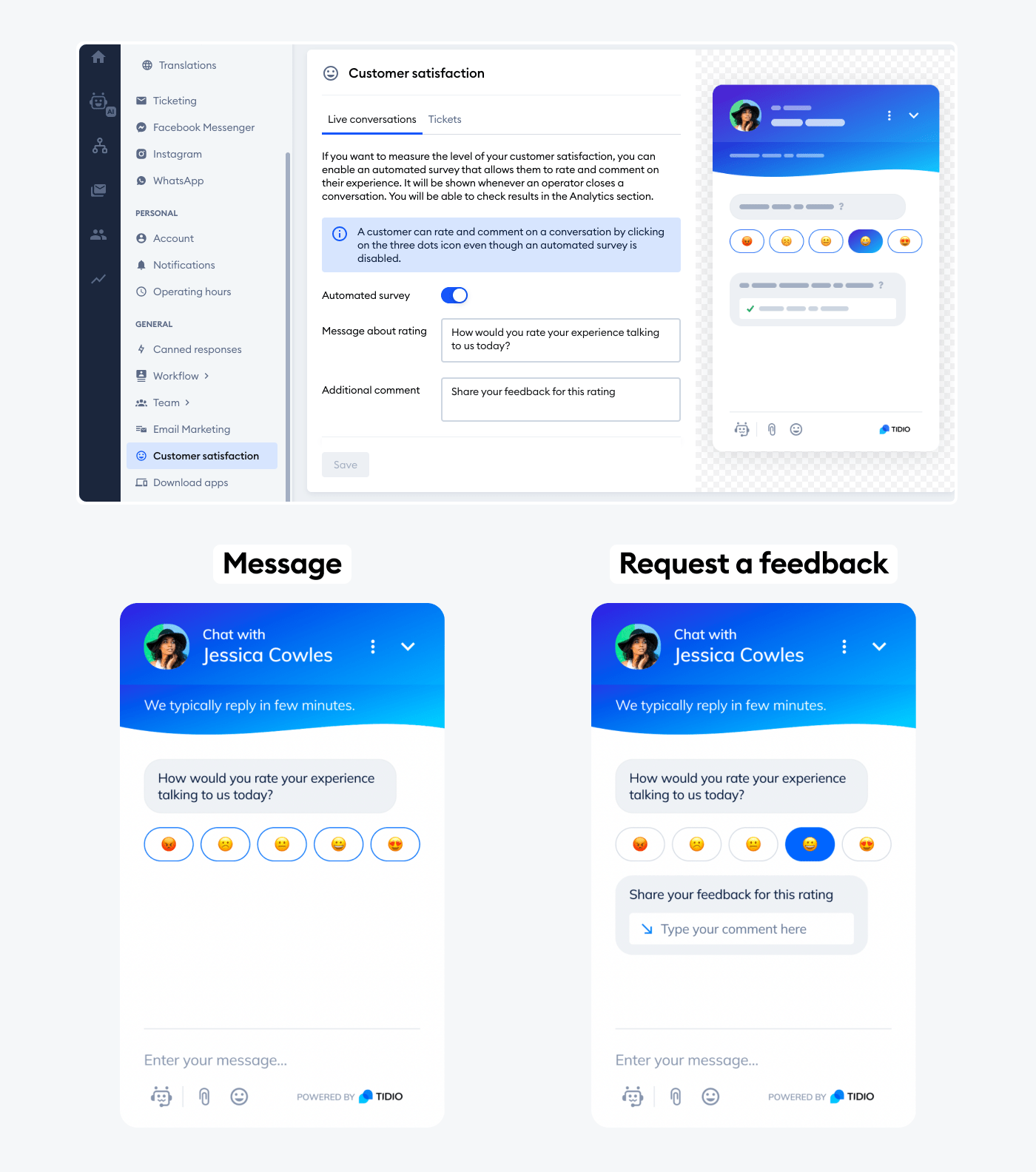
You’ll get to add the custom message that appears above the rating options as well as the feedback-related text that’svisible above the comment field.
Read more: Learn all about the importance of adding ratings and reviews.
12. Perform continuous tests and optimization
Conducting regular dry runs with hypothetical scenarios could help you identify potential hurdles in your workflow. If the response time or resolution process for particular scenarios is far from ideal, there may be a need to refine procedures, retrain staff, or even revamp the whole operation.
Why is performing tests a vital part of your help desk checklist?
Regular tests and optimization of your help desk practices guarantee that your procedures remain efficient, relevant, and adapt to changing business requirements. Continuous testing allows you to discover and fix weaknesses before they lead to more serious problems.
You can test the software you’re using to improve the way you operate your help desk. For example, you can monitor your AI chatbot conversations and improve its knowledge as needed.
How to perform these tests using Tidio?
To test Lyro, Tidio’s conversational AI, you need to first provide it with knowledge first. Then, either click on Test Lyro located in the upper right corner of the Lyro window, or choose the Playground option in the left panel.
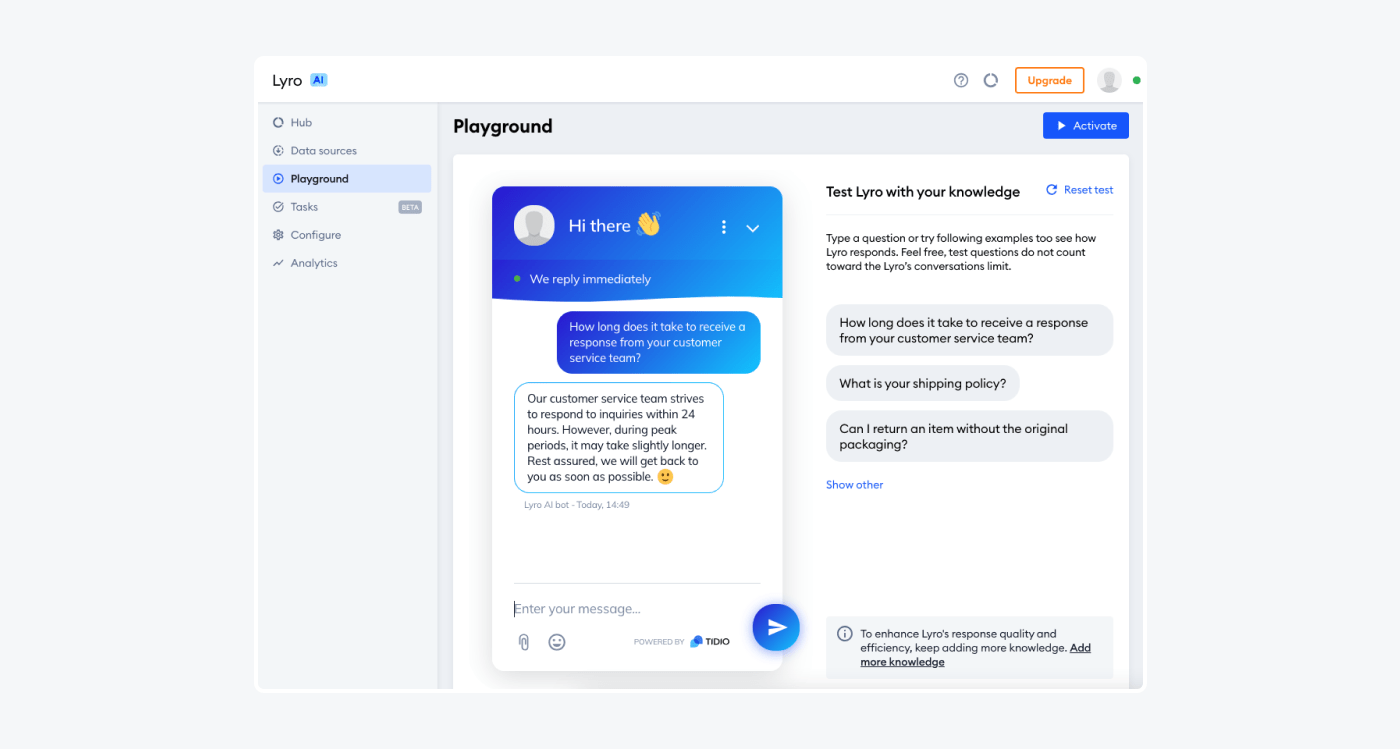
From there on, you can ask Lyro questions to see how it responds.
And remember—to improve the quality of your conversational AI, just continue to add more knowledge to it.
Read more: Learn helpful tips you can use to train an AI.
Help desk checklist template
A help desk checklist template can help provide a kind of sketch for the checklist, with clearly defined steps and tasks you should take so that no critical aspect is overlooked. This ensures all the points in the checklist are consistent.
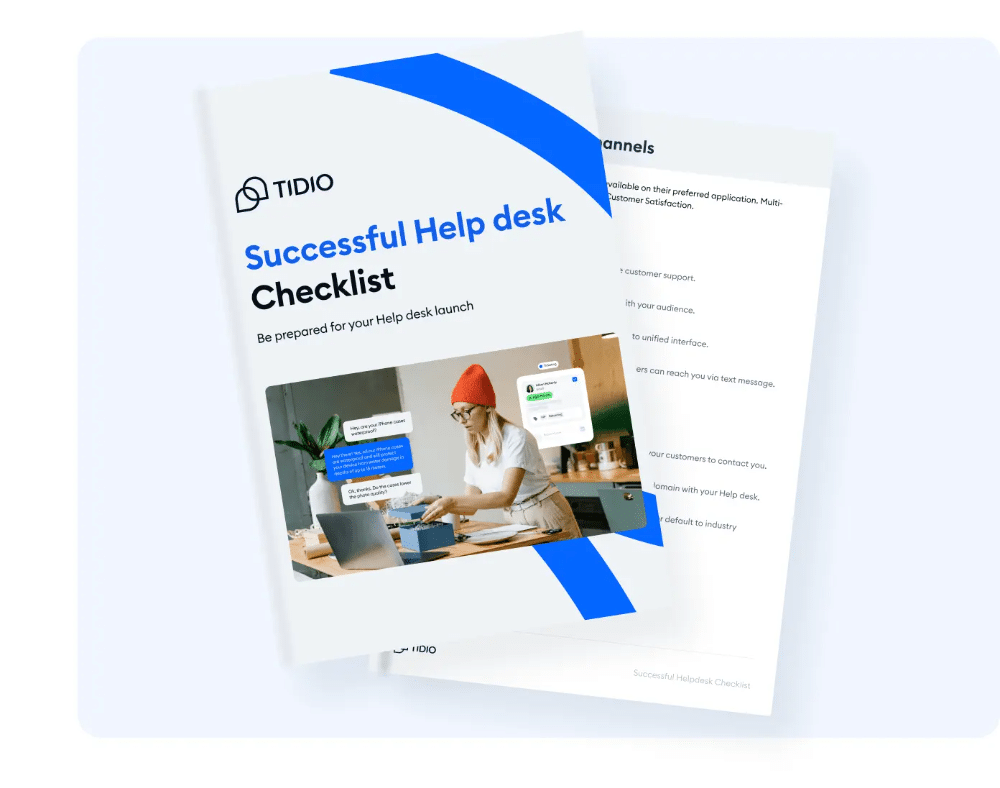
We encourage you to download our own help desk checklist template. It contains 30 essential checklist items that will assist you in setting your help desk up for success. If you use this template, you will save yourself time you’d otherwise spend on creating one from scratch.
This quick and practical cheat sheet will help increase your team’s productivity while enhancing the overall value of your customer service tool.
Read more: Explore these essential help desk response templates.
Increase the value of your help desk with a practical cheat sheet
Help desk checklist: summary
A successful help desk quality assurance checklist often includes the following:
- Clear communication channels
- Well-defined roles and permissions
- Set operating business hours
- Organized agents by departments
- Streamlined help desk workflows
- Available automation options
- Ticket distribution
- Ticket prioritization
- AI and chatbots
- Performance analysis
- Customer feedback
- Regular tests and optimization
By using these strategies and continually striving for improvement, you will surely establish excellent customer support while maintaining lasting relationships with your clients.
Frequently Asked Questions (FAQs)
A help desk typically consists of:
1. Help desk staff
2. Help desk software.
3. Communication channels
4. Knowledge base
5. Workflow processes
6. Reporting and analytics tools
7. Automation capabilities
Running a successful help desk involves a combination of effective strategies, streamlined processes, and efficient team management. Here are a few key steps:
– Hire skilled help desk agents with good technical and customer service skills
– Constantly train your team on your products, services, and customer-handling skills
– Set up clear workflows that define how tickets are handled
– Aim to provide timely and high-quality support to enhance customer satisfaction
– Use AI and chatbots to automate routine tasks
– Enable customers to reach you through multi-channel options
– Continuously seek feedback from customers to identify areas of improvement
– Continually test and refine your processes for better efficiency
While many aspects of a help desk role are essential, the most critical element is often providing excellent customer service. This includes not just resolving technical issues, but also interacting with customers in a manner that is empathetic and professional.
